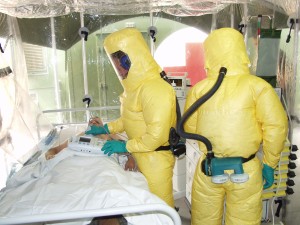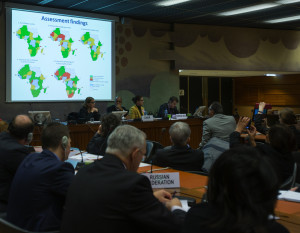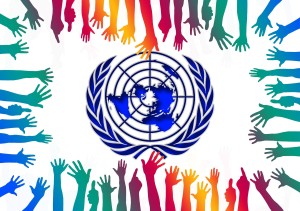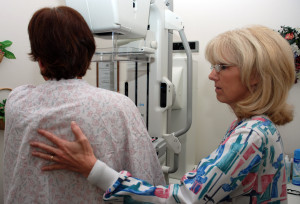Here are the most important public health issues that made headlines.
1. PERSONALIZED MEDICINE

By Ayswaryak via Wikimedia Commons
Most medical protocols are based on treating the average patient. Personalized medicine allows health providers to tailor prevention and treatment based on an individual’s genetics, health, environment, and lifestyle. In January 2015, President Obama announced his Precision Medicine Initiative that will support research into how to tailor treatments and care to individuals. The Initiative will also recruit a million volunteers to participate in a database that researchers will study in order to improve health outcomes and design patient-specific treatments.
2. “SITTING IS THE NEW SMOKING”
via pixabay
Even in people who exercise regularly, research is finding that sitting for prolonged periods of time can have negative health consequences. Previous studies have linked sedentary lifestyle and increased risk for cardiovascular disease, diabetes and death, but this study published in January 2015 suggests that regular exercise, while better than no physical activity, does not eliminate the effects sitting for long periods of time. For those whose job requires long periods of sitting, the authors recommend taking small breaks throughout the day to get up and move around.
3. UPDATED DIETARY GUIDELINES FOR AMERICANS
via pixabay
Every five years, the Department of Health and Human Services (DHHS) and the Department of Agriculture (USDA) update recommended dietary guidelines based on current research and knowledge. In February 2015, the DHHS and USDA submitted the Scientific Report of the 2015 Dietary Guidelines Advisory Committee to the HHS and USDA. There were a few notable updates to previous editions, including an emphasis on overall patterns of eating rather than focusing on individual nutrients. The upper limit for consumption of cholesterol was omitted because there is not adequate evidence that dietary cholesterol causes significant impact on blood cholesterol in most people. The language around sugars was changed to recommend limits to added sugars, as opposed to naturally occurring sugars. Although not a nutrient, caffeine was added as a dietary component that, in moderate amounts, can be incorporated into a healthy eating pattern.
Food labels are also due for an update, and will reflect some of the updated guidelines, such as updated serving sizes and including a recommended %DV of “added sugars”.
4. OVERDOSE
via pixabay
Each day, 44 people in the United States die from overdose of prescription painkillers. On March 26, 2015, the Health and Human Services Secretary Slyvia Burwell announced an initiative in response to the growing rate of heroin and opiod-related abuse, overdose and death. Since then, a number of government agencies and other organziations have coordinated efforts to address the public health issue of overdose. The CDC and Department of Health and Human Services launched two new programs to address the overdose epidemic: Prescription Overdose: Prevention for States and a social media campaign, When the Prescription Becomes the Problem, which lets people share their stories of addiction or loss of a loved one to overdose. The American Academy of Physicians joined the American Medical Association’s Taskforce to Reduce Opiod Abuse, a group focused on identifying and sharing best practices.
5. ANTIBIOTIC RESISTANCE
Scanning electron micrograph of neutrophil ingesting methicillin-resistant Staphylococcus aureus bacteria. Photo Credit: NIAID
Antibiotic resistance occurs when bacteria can resist the effects of antibiotic drugs and continue to grow and spread. Simply using antibiotics is the biggest risk factor for resistance, and the problem is compounded by overuse and misuse of these drugs as well as antibiotic use in animals. World wide, the majority of people do not understand drug resistance or have misconceptions about causes and prevention. According to the CDC, in the US there were 23,000 deaths related to antibiotic-resistant infections in 2015. On March 27, 2015, the Obama Administration issued a National Action Plan to Combat Antibiotic Resistant Bacteria to protect against the re-emergence of diseases and infections that is to be implemented over the next five years. This issue is also being addressed globally through the Global Health Security Agenda, which currently has commitments from 30 countries to work together to prevent, detect, and respond to disease threats.
Visit http://www.cdc.gov/drugresistance/about.html to learn more about antibiotic resistance.
6. EBOLA OUTBREAK
via pixabay
Last year, governments and health agencies continued to address the largest Ebola outbreak in history. The 2014 Ebola epidemic affected multiple countries in West Africa and a few cases were imported to the United States and Europe. There were 11,301 deaths attributed to the outbreak in West Africa. Widespread transmission has been controlled and health agencies partnered to increase the capacity for emergency preparedness and response for future outbreaks. In April 2015, the Sierra Leone Trial to Introduce a Vaccine against Ebola (STRIVE) was launched in areas that were heavily affected by the outbreak. Researchers hope to provide a vaccine that protects against Ebola infection.
7. WOMEN’S REPRODUCTIVE HEALTH
Photo Credit Thoughtcatalog.com via Flickr
In May 2015, the Department of Health and Human Services (HHS) clarified the requirements for insurers to cover contraceptive methods under the Affordable Care Act (ACA). Despite a requirement under the ACA, a nonpartisan research group found that insurers held conflicting policies and not all approved forms of contraception were being covered.
8. FDA BANS TRANS FATS
By Stan Dalone via Wikimedia Commons
In a move called “bold and courageous” by Steven Nissen, chairman of cardiovascular medicine at the Cleveland Clinic, the FDA announced a ban on trans fats in June 2015. Trans fats increase a product’s shelf life, but are so unhealthy the American Public Health Association says that even very small amounts add up and there is no safe level. Doctors estimate that banning trans fats will prevent 20,000 heart attacks and 7,000 deaths from heart attacks each year. Manufacturers have three years to eliminate or replace trans fats or apply for an exception. Examples of products containing trans fats, also known as partially hydrogenated oils, include spreads such as margarine; baked goods such as frozen pizza, biscuits, and cookies; and fried foods such as donuts.
9. VACCINES
By Apotek Hjärtat via Flickr
In 2000, the Centers for Disease Control and Prevention (CDC) declared that measles had been eliminated in the United States. Since that time, there has been a rise in measles cases attributed to unvaccinated individuals who are exposed to the virus while traveling outside of the United States or who are exposed when the virus is imported by visitors from other countries.
An outbreak occurred at an amusement park in California at the end of 2014 and lasted through April 2015, infecting 147 people in multiple states. On June 30, 2015, the governor of California signed a law that mandates vaccination for children in school and daycare, with limited exemptions. Since that time, the rate of vaccination for school children in California has increased from 90.4% in 2014 to 92.9% at the end of 2015.
The American Academy of Family Physicians (AAFP) also released a new policy supporting vaccination and rejecting nonmedical exemptions. In recent years, there has been controversy over a link between vaccination and autism, but the CDC has refuted the link based on research.
10. GLOBAL HEALTH SECURITY AND SURVEILLANCE
Photo Credit U.S. Mission Geneva/ Eric Bridiers via Flickr
With increased globalization, people and products are traveling more and faster than ever. At the same time, outbreaks of infectious disease are able to spread faster than ever. The Global Health Security Agenda (GHSA) is an initiative committed to prevention, detection, and response to infections outbreaks and natural disasters that is comprised of over 40 countries. This year, representatives from Canada, Chile, Finland, India, Indonesia, Italy, Kenya, the Kingdom of Saudi Arabia, the Republic of Korea, and the United States formed a Steering Group to identify challenges and drive progress toward GHSA goals. The United States has committed to assist at least 30 countries in reaching these goals, and announced in July 2015 that it would invest over $1 billion in resources.
11. OBESITY AND DIABETES
via Pixabay
A link between Coca-Cola the Global Energy Balance Network (GEBN) was exposed in August 2015, causing critics to question the integrity of research put out by the anti-obesity group. In addition to discovering that Coca-Cola provides financial support for GEBN, emails revealed that the two groups were working to benefit each other: GEBN promoted increased activity instead of adapting diet and reducing sugar intake, and Coca-Cola supported a vision for GEBN to “quickly establish itself as the place the media goes to for comment on any obesity issue”. Shortly after the connection to Coca-Cola was exposed, the GEBN shut down due to “resource limitations”.
In August 2015, a Harvard study estimated that, globally, 184,000 deaths per year could be attributed to consuming sugar-sweetened beverages (SSB), with over 70% of those deaths due to diabetes. The conclusion is that reducing SSB intake may prevent some of these deaths.
12. RISING PRESCRIPTION DRUG PRICES
Photo Credit StockMonkeys.com via Flickr
In August 2015, the CEO of Turing Pharmaceuticals acquired a drug that has long been on the market and raised the price from $13.50 to $700 per pill. Public outcry and a social media frenzy led to increased attention to an ongoing congressional investigation, public comment from politicians, and a dip in the stock market.
There is growing concern over the skyrocketing prices of treatments such as insulin and drugs for multiple sclerosis, chronic hepatitis C, and cancer, among other things. Unable to afford these medications, patients may take them less frequently or not at all. A poll by Kaiser Health this year found that 54% of Americans are taking some kind of prescription drug and that 72% think that the cost of prescription drugs is unreasonable.
13. THE SOCIAL MEDIA EFFECT
via Pixabay
In 2014, over 17 million people participated in the Ice Bucket Challenge to raise money for ALS (Amyotrophic lateral sclerosis, also known as Lou Gehrig’s Disease). Videos flooded the internet, challenges were accepted, and even celebrities and professional athletes drenched themselves with icy cold water for the cause. The donations that poured in more than tripled donations the ALS Association received the previous year. In August 2015, researchers announced a breakthrough that may lead to a cure, and they credit the extra funding for making the research possible. Due to the success of the social media campaign and ongoing efforts for identifying a cure, the Association is continuing the Ice Bucket Challenge: #EveryAugustUntilACure.
14. POLLUTION
via Pixabay
Pollution causes more than 5 million premature deaths globally each year, and half of those deaths occur in India and China alone. Poor air quality is one of the leading risk factors for disease and the fourth highest risk factor for death. Two studies published in September 2015 examined country-specific data on sources of pollution and health outcomes, and concluded that air pollution solutions have to be on a country-by-country basis.
Sources of pollution include powerplants, industrial manufacturing, vehicle exhaust, and burning wood, coal and biomass. The Global Burden of Disease study found that even though pollution has decreased in most high-income countries, 87% of the world’s population live in environments exceeding the World Health Organization’s recommended maximum levels of exposure.
15. NEW SUSTAINABLE DEVELOPMENT GOALS
via Pixabay
Adopted in 2000, the United Nations adopted the Millennium Development Goals (MGDs) to address 8 targets, including reducing extreme poverty, by the year 2015. Three of the eight were achieved before 2015, but progress towards the MGDs in general was inconsistent across countries. As the 2015 deadline for the MGDs approached, the United Nations worked on a post-2015 development agenda in consultation with over 70 countries. In September 2015, world leaders adopted 17 Sustainable Development Goals (SDGs) to be reached by 2030. The SDGs build upon the successes of the MGDs, but differ in that they address root causes of poverty, are universal instead of focusing solely on developing countries, and address climate change as an essential component.
16. FOODBORNE ILLNESS
Photo Credit James Palinsad via Flickr
In October 2015, over 20 people in the states of Washington and Oregon became sick from E. Coli after eating at a Chipotle restaurant. During the investigation, 43 Chipotle restaurants were temporarily closed. The outbreak was not isolated to the Pacific Northwest; eventually over 50 people’s illnesses in 7 states were linked to this strain of E. Coli. This was not the first time Chipotle restaurants have been linked to an outbreak; in fact, this was one of five outbreaks in 2015 that resulted in over 350 people sickened.
In addition to the Chipotle E. Coli outbreak, there were 9 others in the United States this year that victimized even more people, including a few deaths. While deaths are relatively rare (3,000 per year), about 1 in 6 americans will suffer from foodborne illness each year. Multistate outbreaks have increased in severity since 2010, and despite the fact that E. Coli outbreaks have decreased, other pathogens have not decreased and more severe strains are emerging, making foodborne illness a public health concern to be monitored.
17. NEW MAMMOGRAM RECOMMENDATIONS
By U.S. Navy photo by Mass Communication Specialist 2nd Class Joseph Moon [Public domain], via Wikimedia Commons
There has been ongoing debate as to who should be getting screened for breast cancer and when. Mammography can save lives by detecting breast cancer in early stages, but it has significant risks and drawbacks. False positive results may lead to severe anxiety and unnecessary treatments or procedures. But mammography remains the most effective screening tool, therefore it is recommended that women weigh the risks and benefits based on their personal health and history with their doctor.
In October 2015, which is Breast Cancer Awareness Month, the American Cancer Society released updated guidelines for screening: women at average risk should begin yearly mammograms at age 45 and at age 55 switch to every other year, but may begin as early as age 40 if desired. Breast exams and self-exams are no longer recommended.
18. AFFORDABLE CARE ACT
Photo Credit George Miller via Flickr
The Affordable Care Act continues to draw both praise and criticism. It has been hailed for historical gains – according to the CDC in a report released in November 2015, the percent of uninsured Americans in mid-2015 was 9%, an all-time low. Some states have embraced the ACA and seen benefits, others have resisted and have gone so far as to sue the government, challenging fees or requirements of the ACA. There have been more than 50 votes to repeal the ACA, it has been challenged in the Supreme Court, and it was a factor in the government shutdown of 2013.
19. SMOKING AND E-CIGARETTES
Photo Credit Vaping360.com via Flickr
Although the number of adults who smoke has decreased, smoking continues to be the leading cause of preventable death in the US. Public health still faces challenges in addressing e-cigarettes (and other forms of smokeless tobacco) and tobacco use in teens. E-cigarettes have been marketed as tools to help people quit smoking, but they have been found to reduce the likelihood of quitting.
2015 saw the FDA continue to work on regulatory oversight of tobacco products, including study and research of currently unregulated products such as e-cigarettes, cigars and hookah tobacco. It also saw a proposal in November 2015 to make public housing smoke free – according to the CDC, renters are twice as likely as homeowners to be exposed to secondhand smoke.
20. FIREARM-RELATED INJURY AND DEATH
via Pixabay
Although highly controversial in the media and politics, firearm-related injuries and deaths have been recognized as a major public health issues by the American Public Health Association, with 32,000 deaths and over twice as many non-fatal injuries. These deaths and injuries are a result of a number of different causes, both intentional and unintentional. Some are highly publicized, including an 8-year old shooting his friend in the face while playing cops and robbers with a loaded rifle; families lost to quadruple murder-suicide; and mass shootings, such as the San Bernardino attack that killed 14 and injured 17. However, most injuries and deaths do not make national headlines: 60% of firearm-related deaths are by suicide.
In a letter to House and Senate leaders in December 2015, the American Academy of Family Physicians cited the physical and psychological impacts of gun violence in their local communities in a request to end the ban on funding for research on firearm-related injury and deaths. This letter was preceded by a call to action in April by 8 professional organizations: the American Academy of Family Physicians, American Academy of Pediatrics, American College of Emergency Physicians, American Congress of Obstetricians and Gynecologists, American College of Physicians, American College of Surgeons, American Psychiatric Association, the American Public Health Association, and the American Bar Association. A 1996 amendment restricted federal funding from being used for firearm-related injury research, and as of 2013, funding for firearm-related injury had decreased by 96%.

















